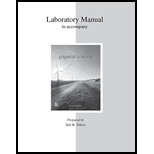
A 1 cm thick piece of lead with a surface area of 160 cm2 is placed on the surface of Mercury for 1 hour during the time the planet receives its peak solar energy. Assume the lead absorbs all of the solar energy, and its temperature when placed is at absolute zero. Will the energy received raise the temperature of the lead to its melting point of 327°C? If so, determine the mass of lead that melts. (Assume Lf of lead is 5 cal/g.)
The mass of lead melts, if the energy received raise the temperature of the lead to its melting point of
Answer to Problem 8PEB
Solution:
Explanation of Solution
Given data:
A
The energy received raise temperature of the lead to its melting pon of
Latent heat of lead is
Formula used:
Write the expression of density.
Here,
Write the formula for heat:
Here,
Write the equation for latent heat
Here,
Explanation:
According to the question volume of lead is as follows:
Recall the expression of density to find the mass of lead.
Substitute
Determine the energy required to heat the lead to its melting point:
Mass of lead is
Specific heat of mercury is
Initial temperature is
Final temperature is
Recall the formula for heat:
Substitute
Refer the table 15.1 to the value of mercury of solar energy received.
Convert time to seconds:
Determine the energy received, use solar energy received multiply it by the area and the duration of the time.
Substitute
Compare the energy received to the energy required to heat the lead and its melting point:
Therefore, the lead will reach its melting point.
Determine the excess energy:
Substitute
Recall the equation for latent heat
Substitute
Conclusion:
The mass of lead melts are
Want to see more full solutions like this?
Chapter 15 Solutions
Lab Manual for Physical Science
- Which planet has the strongest magnetic field, and hence the largest magnetosphere? What is its source?arrow_forwardWhich of the following planetary traits is well established? choose one of the following: a) Mercury has a similar compositon to that of our moon, in that they both have a substantial metal content. b) Venus rotates more rapidly than Earth, but in the opposite direction. c) Earth's atmosphere exhibits a slightly stronger greenhouse effect than that seen on Venus. d)Astronomers have precisely calculated the mass of Mercury thanks to artificial satellites sent from Earth.arrow_forwardWhich of the following is NOT best explained by Venus's extreme greenhouse effect? a. its extremely high surface temperature b. its extremely uniform surface temperature c. its extremely low surface wind speeds d. its lack of magnetismarrow_forward

 Foundations of Astronomy (MindTap Course List)PhysicsISBN:9781337399920Author:Michael A. Seeds, Dana BackmanPublisher:Cengage Learning
Foundations of Astronomy (MindTap Course List)PhysicsISBN:9781337399920Author:Michael A. Seeds, Dana BackmanPublisher:Cengage Learning
 AstronomyPhysicsISBN:9781938168284Author:Andrew Fraknoi; David Morrison; Sidney C. WolffPublisher:OpenStax
AstronomyPhysicsISBN:9781938168284Author:Andrew Fraknoi; David Morrison; Sidney C. WolffPublisher:OpenStax An Introduction to Physical SciencePhysicsISBN:9781305079137Author:James Shipman, Jerry D. Wilson, Charles A. Higgins, Omar TorresPublisher:Cengage Learning
An Introduction to Physical SciencePhysicsISBN:9781305079137Author:James Shipman, Jerry D. Wilson, Charles A. Higgins, Omar TorresPublisher:Cengage Learning




